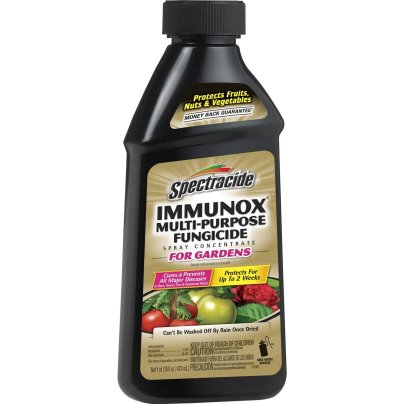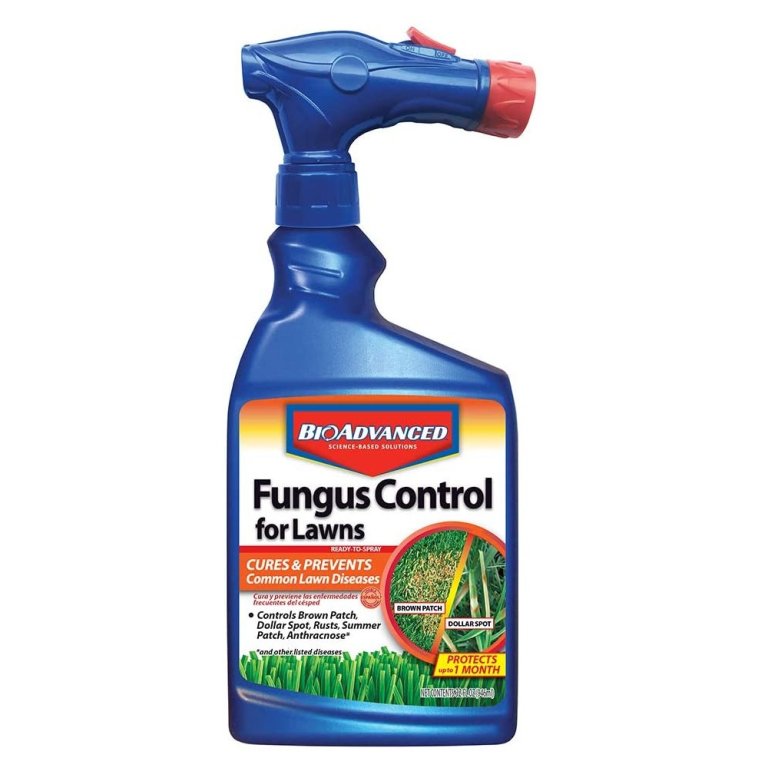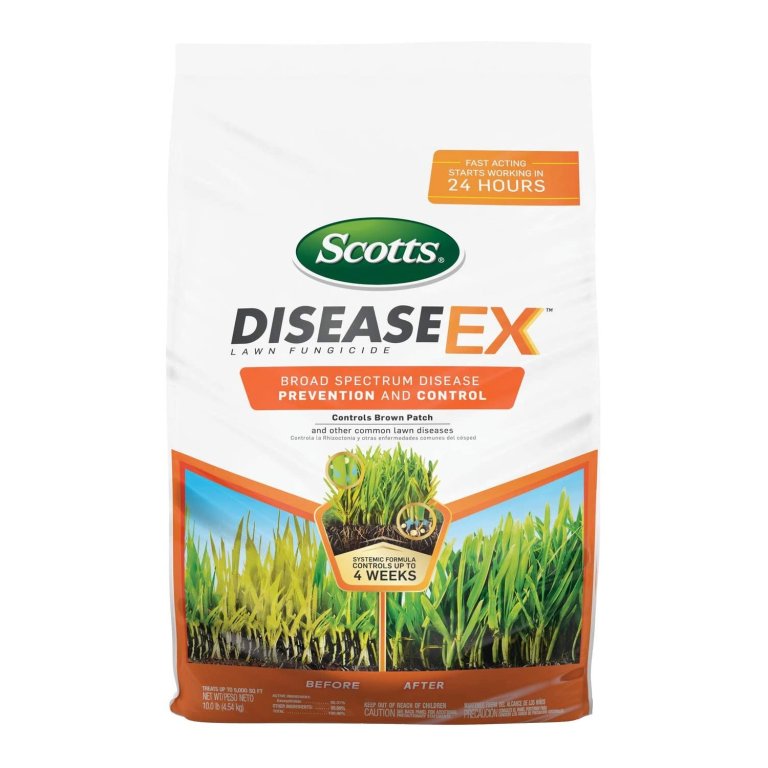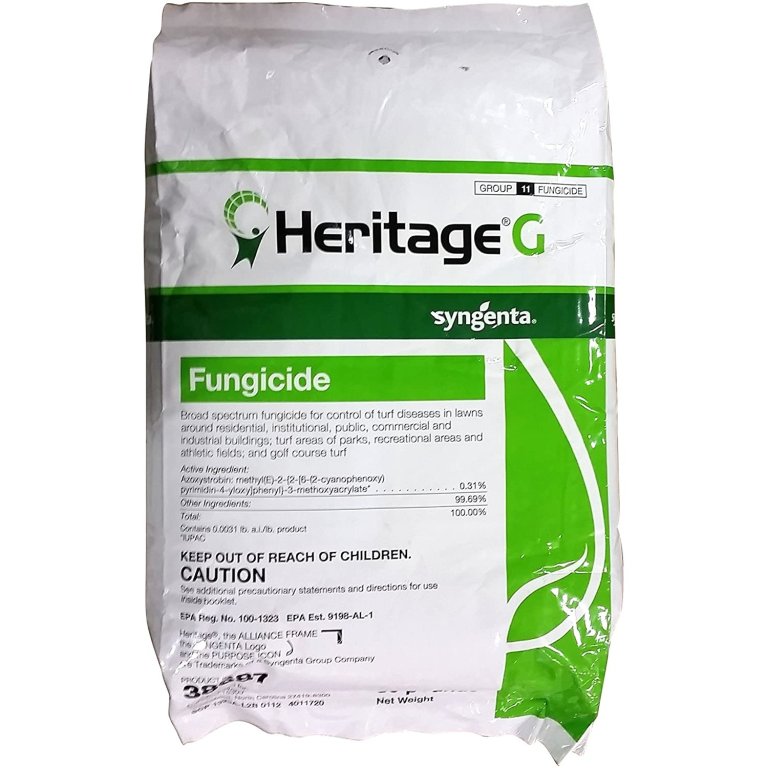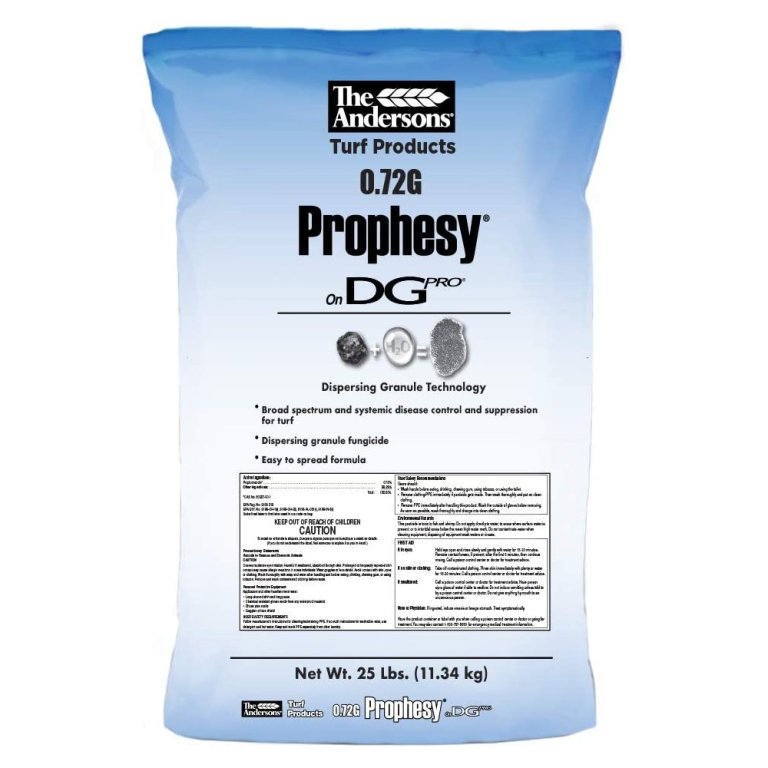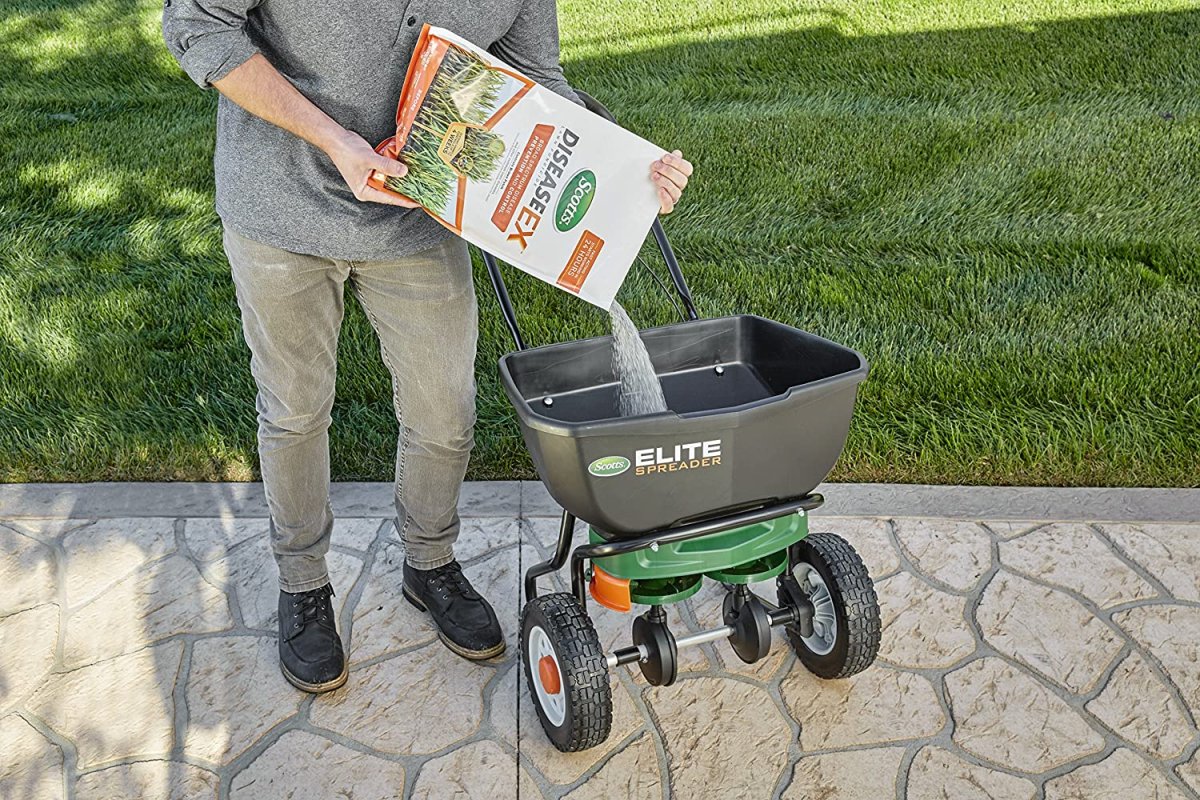
We may earn revenue from the products available on this page and participate in affiliate programs. Learn More ›
Lawn fungicides are made with biocidal chemical compounds or biological organisms that kill parasitic fungi and/or their spores. Some products are formulated to stop an active fungal infestation, while others can be used as preventive lawn care aids to keep a healthy lawn looking great.
While it can be difficult for the average person to identify specific types of lawn fungus, there are some telltale signs your lawn has a fungal problem, says Steve Corcoran, CEO of Lawn Love, headquartered in San Diego, California. “Some of the most common visual signs include grass discoloration (yellowing or even red patches are most common, though white, black, purple, and gray patches are also possible), dying or dead patches (often in circular patterns), a powdery substance coating the grass blades, slimy/fuzzy growth, or clear fungal growth like mushrooms.”
After reviewing dozens of lawn fungicides, our top pick is the BioAdvanced Fungus Control for Lawns. Its broad-spectrum formula treats and prevents 14 common types of lawn diseases for up to 30 days. However, depending on the type of fungi and your needs, a different product may be better suited for your lawn. Read on to discover some of the best lawn fungicides for keeping grass healthy.
- BEST OVERALL: BioAdvanced Fungus Control for Lawns
↓ Jump to Review - BEST BANG FOR THE BUCK: Spectracide Immunox Multi-Purpose Fungicide
↓ Jump to Review - BEST GRANULAR: Scotts DiseaseEx Lawn Fungicide
↓ Jump to Review - BEST BROAD-SPECTRUM: Syngenta Heritage G Fungicide
↓ Jump to Review - ALSO CONSIDER: The Andersons Prophesy
↓ Jump to Review
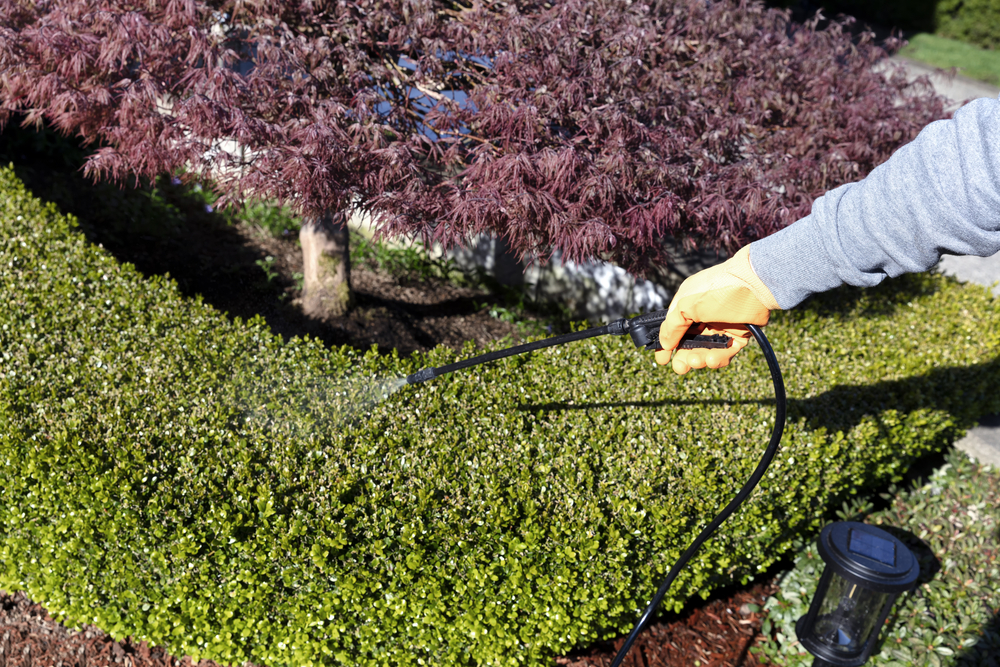
Lawn Fungicides Comparison Chart
| Application Type | Contact or Systemic | Coverage | |
| BioAdvanced Fungus Control for Lawns | Concentrated liquid with hose-end applicator | Systemic | Up to 5,000 square feet |
| Spectracide Immunox Multi-Purpose Fungicide | Concentrated liquid (sprayer not included) | Systemic | Up to 2,500 square feet |
| Scotts DiseaseEx Lawn Fungicide | Granules, spreader (not included) | Systemic | Up to 5,000 square feet |
| Syngenta Heritage G Fungicide | Granules, spreader (not included) | Systemic | Up to 15,000 square feet |
| The Andersons Prophesy | Granular, spreader (not included) | Systemic | Up to 10,000 square feet |
Our Top Picks
In our quest to find the best fungicide, we extensively researched dozens of products that claim to treat and prevent fungal infestations in lawns. To qualify for a spot on this lineup, the fungicide had to indicate whether it was a broad-spectrum product or designed to treat only one or two types of fungal infestations. Mixing instructions (if applicable) had to be simple to understand and follow, and the product had to come with positive reviews from users who applied it to their lawns.
Best Overall
BioAdvanced Fungus Control for Lawns
See ItWhat We Like
- Nothing to mix or measure
- Easy to apply with included hose-end sprayer
- Protects up to 30 days after treatment
What We Don’t Like
- May not kill all types of lawn fungus
Product Specs
- Application type: Concentrated liquid with hose-end applicator
- Contact or systemic: Systemic
- Coverage: Up to 5,000 square feet
Designed to kill and prevent brown patch, summer patch, red thread, and other fungi-related lawn diseases, BioAdvanced Fungus Control for Lawns is simple to apply and effective. We like that it comes as a concentrated liquid in a hose-end dispenser that attaches to a standard garden hose for easy spray application.
One 32-ounce container of this liquid fungicide for lawns will treat up to 5,000 square feet. This is a systemic fungicide absorbed by the grass blades to kill existing fungal infestations, and it remains active within the grass to protect the lawn for up to 30 days against reinfestation. Once it dries on the grass, the product is rainproof and won’t wash away. A broad-spectrum fungicide, BioAdvanced targets many of the most common types of fungal infestations, so it’s highly effective for controlling most lawn diseases.
Get BioAdvanced lawn fungicide at Amazon, Lowe’s, Tractor Supply Co., Ace Hardware, or The Home Depot.
Best Bang For The Buck
Spectracide Immunox Multi-Purpose Fungicide
See ItWhat We Like
- Budget-friendly
- Treats common lawn fungus problems
- Protects up to 2 weeks
What We Don’t Like
- No sprayer included
Product Specs
- Application type: Concentrated liquid (sprayer not included)
- Contact or systemic: Systemic
- Coverage: Up to 2,500 square feet
Keeping the lawn fungus-free needn’t cost a bundle. Spectracide Immunox Multi-Purpose Fungicide is made to kill a wide variety of fungi that can cause brown patch, black spot, powdery mildew, and more. It’s suitable for lawns, trees, shrubs, and ornamentals, including roses, and it’s a budget-friendly pick.
Immunox lawn fungus treatment is available as a concentrated liquid that must be diluted with water before use. It can be used in a trigger-type hand sprayer to treat small areas or applied with a pump-type garden sprayer where broader coverage is desired. One 16-ounce bottle will cover up to 2,500 square feet of lawn. Coverage on trees and shrubs will vary depending on the size of the specimens.
Get Spectracide Immunox multi-purpose fungicide at Amazon, Lowe’s, Ace Hardware, or Walmart.
Best Granular
Scotts DiseaseEx Lawn Fungicide
See ItWhat We Like
- No mixing or mess
- No risk of overspray
- Prevents infestations for up to 4 weeks
- Can apply simultaneously with fertilizer
What We Don’t Like
- Spreader required but not included
Product Specs
- Application type: Granules, spreader (not included)
- Contact or systemic: Systemic
- Coverage: Up to 5,000 square feet
There’s no mixing, no mess, and no need to worry about overspray when applying Scotts DiseaseEx Lawn Fungicide. This systemic fungicide prevents mold, mildew, and other fungi from destroying turfgrass. Scotts, a recognized leader in lawn seed, fertilizer, and treatment products, developed DiseaseEx to target 26 common fungal diseases, including brown patch, pink snow mold, and fairy ring, making it a broad-spectrum fungicide.
This grass fungus killer comes in granular form and should be applied with a broadcast spreader or a drop spreader. One 10-pound bag of DiseaseEx granular fungicide for lawns treats up to 5,000 square feet. The granules dissolve quickly and are absorbed by grass blades to kill existing fungi and protect the lawn for up to 4 weeks. In addition, users can apply fertilizer simultaneously to the lawn and then water to disperse both products at once.
Get Scotts lawn fungicide at Amazon, Lowe’s, Ace Hardware, The Home Depot, or Walmart.
Best Broad-Spectrum
Syngenta Heritage G Fungicide
See ItWhat We Like
- Dissolves quickly for easy dispersion
- Treats more than 20 types of fungal diseases
- Protects up to 28 days
What We Don’t Like
- May damage apple trees
- Spreader required but not included
Product Specs
- Application type: Granules, spreader (not included)
- Contact or systemic: Systemic
- Coverage: Up to 15,000 square feet
Syngenta Heritage G Fungicide treats and prevents more than 20 different fungal diseases, including common ones such as brown patch as well as less common varieties like necrotic ring spot. We like that the granules in Heritage G Fungicide dissolve quickly with light watering, rain, or even heavy morning dew, which reduces the risk of the product washing away or being picked up and bagged by a mower. The active ingredients are absorbed by grass blades, where they destroy existing fungal infestations and prevent reinfestation for up to 28 days.
One 30-pound bag treats up to 15,000 square feet of lawn. A potential downside to Heritage G is that it can harm apple trees and should not be used where dissolved granules could be absorbed by apple tree roots. Folks with apple trees on their property may wish to opt for a different fungicide to be safe.
Get Syngenta lawn fungicide at Amazon, Walmart, or Kmart.
Also Consider
The Andersons Prophesy
See ItWhat We Like
- Treats and prevents a wide range of fungal diseases
- Granules dissolve quickly
- Systemic formulation
What We Don’t Like
- Only protects for 2 weeks
Product Specs
- Application type: Granular, spreader (not included)
- Contact or systemic: Systemic
- Coverage: Up to 10,000 square feet
The Andersons Prophesy fungicide for grass controls and prevents common fungal diseases, including brown spot, dollar spot, and pink patch. It comes in quick-dissolving granular form and can be reapplied every 2 weeks as necessary to keep the grass free of fungus.
One 25-pound bag of The Andersons Prophesy lawn fungus control treats up to 10,000 square feet of lawn, and users should apply the product with either a drop spreader or a broadcast spreader (not included). This fungicide is especially well suited as part of a preventive disease control program. It is both broad-spectrum and systemic and can keep fungus-related diseases away with regular use.
Get The Andersons Prophesy lawn fungicide on Amazon, Walmart, and Seed World.
Our Verdict
While any lawn fungicides in this lineup will treat and protect turfgrass from various fungal diseases, our best overall pick, BioAdvanced lawn fungicide, ticks all the boxes. It treats most common fungal infestations in lawns and comes in a handy hose-end dispenser. It also protects grass for up to 30 days. Our budget pick, Spectracide Immunox Multi-Purpose fungicide, is an affordable option for treating lawns, and it can also be used on shrubs, trees, and other plants.
How We Chose the Best Lawn Fungicides

Before narrowing down our list to the lawn fungicide products in this lineup, we extensively researched dozens of brands and types of fungicides. While we considered brand reputation (such as Scotts, a well-known name in lawn products), we didn’t automatically eliminate smaller manufacturers if the fungicides rated highly with users and effectively treated fungal diseases.
To an extent, we considered cost, but we placed greater emphasis on effectiveness and ease of use. We also tried to avoid fungicides that were highly toxic to humans and pets.
What to Consider When Choosing the Best Lawn Fungicides
With more than 2 million different species of fungi, including all types of mildew, mold, yeast, lawn mushrooms, and smuts, it’s not always possible to pinpoint the exact fungi species causing problems in the lawn. However, almost all grass-related diseases are caused by pathogenic fungi, meaning fungus that can cause an infestation. Hence, the first course of action with any visible lawn problem—including rings of dead grass; slick spots; or unsightly yellow, brown, or rusty patches—is to treat it with a fungicide.
Preventative vs. Curative
While fungicides are loosely grouped into two categories—preventive and curative—all are preventative, but not all are curative. Choosing one will depend on whether there’s an active fungal infestation or whether you want to reduce the risk of one occurring. These products can contain either chemical or natural ingredients. In the long run, it’s better to prevent a fungal infection rather than wait until one occurs and treat it. While a curative will kill an existing fungus, it won’t repair the damaged lawn. The homeowner will have to replant grass in the dead areas.
- Preventative: These fungicides are applied to the lawn before an apparent fungal problem occurs. They help create an environment where fungus spores are less likely to survive and reproduce.
- Curative: Once a fungi infestation begins to spread on a lawn, a more potent antifungal treatment might be necessary to destroy it. Curative fungicides kill the immediate fungus issue and also offer preventative protection for the grass.
Contact vs. Systemic
All lawn fungicides will either kill fungi or prevent it from getting a foothold, but they do so differently, depending on the product.
- Contact: Contact fungicides are used as preventatives only. When applied, they adhere to the surface of grass leaves and form a protective barrier that keeps fungi from reproducing. A downside is that contact-type fungicides don’t last as long or provide as much protection as systemic products.
- Systemic: A systemic fungicide is absorbed into the blades of the grass, where it can travel through the leaves to kill fungi internally and also prevent new infestations. Most of the antifungal lawn products on the market today are systemic.
Broad-Spectrum vs. Narrow-Spectrum
With so many types of fungi that cause lawn problems, many fungicide products are broad-spectrum, meaning they work to kill or prevent infestation from a wide variety of fungal species. While there are exceptions, many systemic fungicides are broad-spectrum because the ability of the grass to absorb the product makes it more effective against a range of fungi. These products often bear the wording “broad-spectrum” on their labels. With a broad-spectrum product, the best fungicide for dollar spot is also likely to be the best fungicide for lawn rust.
While broad-spectrum fungicides eradicate many common types of fungi, they do have one downside, says Corcoran. “Broad-spectrum fungicides can be very effective since they can fight off a variety of different fungi at once. However, using them can also harm the beneficial fungi in your lawn.”
On the other hand, narrow-spectrum fungicides are often contact fungicides that are designed to treat and prevent specific types of lawn fungus species from reproducing. These products aren’t labeled as being narrow-spectrum. Instead, they will often list the type(s) of fungus symptoms they’re designed to treat, such as “brown patch” or “dollar spot.” Narrow-spectrum fungicides typically only treat one or two fungal diseases, so users should know exactly what type of fungal infestation is on their lawn before using a narrow-spectrum product.
Narrow-spectrum fungicides are highly effective against specific fungi species, and they are less likely to kill beneficial organisms such as arbuscular mycorrhizal, a fungi that helps increase nutrient uptake in plants. Unfortunately, if the type of fungus causing damage in the lawn is not known—which is often the case—applying a narrow-spectrum product may not get the job done.
While narrow-spectrum fungicides have their place, all the products in our lineup are broad-spectrum because they offer the widest range of fungal protection.
Application
Fungicides come in various application types—some require mixing, while others come premixed and ready to apply.
- Ready-to-use spray: Designed primarily for treating small areas of damaged grass, ready-to-use spray comes in a bottle with its own nozzle for quick applications directly on the problem areas. This product is often a curative, contact-type fungicide.
- Concentrated liquid: This liquid must be diluted and is often applied with a pump-type sprayer. However, the liquid may come in the form of a convenient garden-hose attachment that automatically dilutes the solution during application. Concentrated liquid fungicides can be curative or preventative, depending on the product itself.
- Granules: Applied with a broadcast spreader or a drop spreader, granular fungicide is a systemic product that dissolves to kill infestations and forms a protective barrier against future fungal infestations. However, some granular products are preventative only. A notable benefit of applying fungicide in granular form is that there is no dilution and no risk of overspray. Plus, users can apply a synthetic or organic lawn fertilizer at the same time and then water the lawn to disperse both.
Safety
Always read and follow the manufacturer’s application instructions carefully. Most yard fungicide products are safe when used as directed, but some may cause irritation if they directly contact skin or eyes or if they’re inhaled. To be on the safe side, wear gloves, long sleeves, and long pants when applying fungicide, and consider wearing a respiratory mask and protective eyewear if you’ll be using a product with a pump-type sprayer.
Antifungal products for use on lawns are typically safe for all types of grass. For the best result, wait 2 weeks after using a lawn fungicide before overseeding with new grass seeds to give the new seeds the best protection possible from fungal disease.
FAQs
If you’ve noticed unsightly brown or yellow patches in the lawn or that grass is dying in spots or looks slimy, there’s a good chance grub damage or fungus is the culprit. Fortunately, most lawn diseases can be treated and controlled by fungicides, while in some specific situations, an insecticide is necessary. If you still have questions about the best fungicide for lawns, read on for answers to some of the most common questions about how to treat grass fungus.
Any of the products in this lineup would be good choices for treating lawn diseases, but our top pick is BioAdvanced lawn fungicide for its ability to treat and prevent a wide range of fungal diseases.
The short answer is as soon as you notice a problem. Prompt treatment will keep the fungal disease from spreading and protect the rest of the yard.
The general rule is to apply a fungicide for lawn treatment in spring when low nighttime temperatures are around 60 degrees Fahrenheit. Then apply additional treatments as recommended on the package.
It depends on the product. Some fungicides can be reapplied every 2 weeks, while others last up to 4 weeks, so follow the manufacturer’s recommended instructions.
If you’re applying a granular fungicide that needs to be watered to dissolve, you can usually apply a fertilizer simultaneously.
When applied as directed, it shouldn’t. However, keep in mind that the fungi that were affecting the lawn may have already damaged some of the grass, which could still die after you’ve applied a fungicide.

